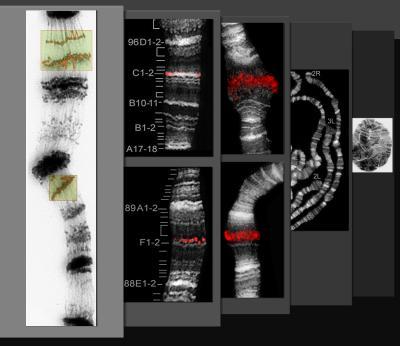Researchers at the University of Illinois have developed a simple and economical technique for imaging and mapping fruit fly chromosomes. This new approach will enable them to construct the first accurate map of the chromosomes and tease out the secrets hidden in their stripes. Developers of the new approach use a technology called Computer Vision to analyze hundreds of crisp images of the same chromosomes. This will allow the production of a much more precise map of the chromosome bands. Credit: Photo courtesy of Dmitri Novikov
Developers of the new approach use a technology called Computer Vision to analyze hundreds of crisp images of the same chromosomes. This will allow the production of a much more precise map of the chromosome bands. Credit: Photo courtesy of Dmitri Novikov
Fruit flies are well suited for chromosome studies because some of their cells contain gigantic, "polytene" chromosomes, each built up of more than 1,000 parallel copies of DNA strands. When stained, condensed, dark bands and lighter regions (interbands) give the chromosomes a striped appearance.
For more than 70 years, cytogeneticists have used a hand-drawn map of the bands of fruit fly polytene chromosomes, with the shape and location of these structures only vaguely delineated. This map, first published in 1935, and generations of light and electron micrographs have yielded an imprecise guide to the chromosomes.
Traditional methods of chromosome preparation have limited usefulness for those hoping to sort out how the bands and interbands relate to the underlying genetic sequence, said cell and developmental biology research specialist Dmitri Novikov, who developed the new technique. The genome of the fruit fly, Drosophila melanogaster, was sequenced in 2000, and yet its relationship to chromosome structure remains unclear.
"Since we want to know what genes are involved in the development of different structures in living systems, this is the first structure to look at," Novikov said. "This is the starting point: the appearance of the genes themselves."
Cell and developmental biology professor and lead investigator Andrew S. Belmont and visiting scientist Igor Kireev, of Moscow State University, are co-authors on the paper. Belmont is in the U. of I. Institute for Genomic Biology and the Center for Biophysics and Computational Biology.
Current methods for preparing polytene cells for viewing under a light microscope involve using a thumb, pencil, forceps or other instrument to maneuver and press the cells between a glass coverslip and slide. Only about 10 percent of the slides processed this way provide useable images and even those rarely offer crisp structural details, Novikov said.
The new approach includes two components: the use of mechanical devices to spread and flatten the cells, and the application of computer-based image processing to analyze hundreds of examples of the same chromosomes. With so many crisp images to analyze, computer algorithms can accurately calculate the number, shape and location of the chromosome bands.
"Two researchers might see the same image differently," said graduate research assistant Mert Dikmen, who uses computer vision technologies under the supervision of Beckman Institute professor Thomas Huang to analyze the images. "Our system will give an impartial estimate of the band location. It will not be researcher-dependent. It will be objective."
To improve chromosome spreading, researchers use a rotary tool that vibrates the coverslip surface for several minutes. A simple mechanical vise applies up to two tons of force to each slide, rendering the preparations very thin and high in contrast. This allows the production of much clearer, information-packed images.
The technique has other advantages: Because it relies on light microscopy, it is faster and more economical than electron microscopy, with comparable or superior results.
With a more accurate chromosome map, researchers will next use fluorescent immunostaining of proteins that bind to specific DNA sequences. These landmarks will help them tease out the relationship of the sequence to the physical structure.
The new approach will allow scientists to answer fundamental questions about chromosome structure, Novikov said. Such questions have relevance across species.